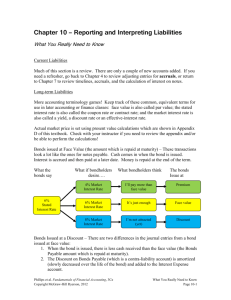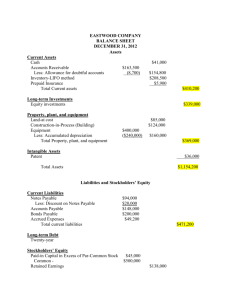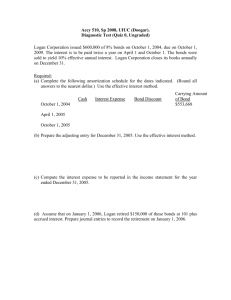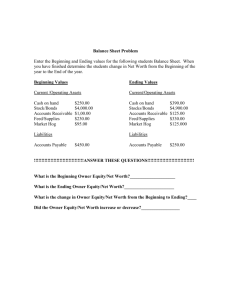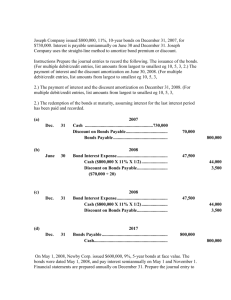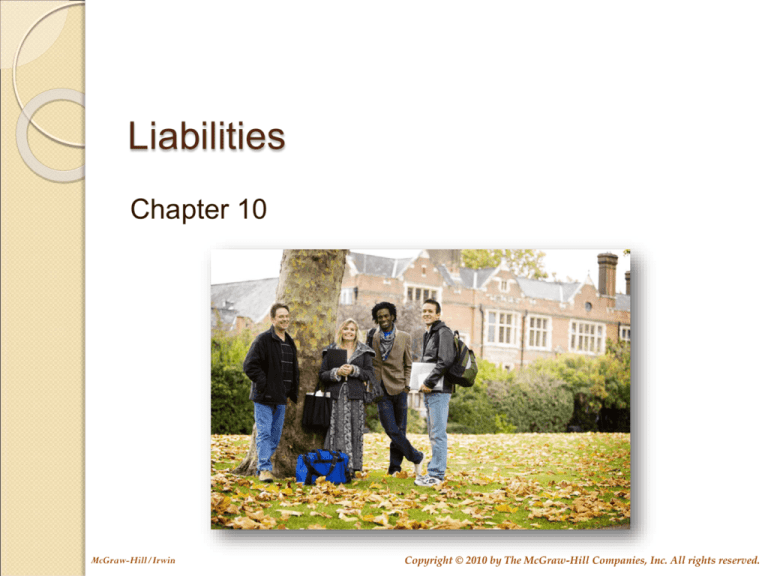
Liabilities
Chapter 10
McGraw-Hill/Irwin
Copyright © 2010 by The McGraw-Hill Companies, Inc. All rights reserved.
The Nature of Liabilities
Defined as present obligations arising from
past events. Their settlement is expected to
result in an outflow of resources.
Maturity = 1 year or less
Maturity > 1 year
Current
Liabilities
Noncurrent
Liabilities
10-2
Distinction Between Debt and Equity
The acquisition of assets is financed
from two sources:
DEBT
Funds from creditors, with
a definite due date, and
sometimes bearing
interest.
EQUITY
Funds from
owners.
10-3
Provisions
Provisions have two basic characteristics:
1.The liability is known to exist,
2.The precise dollar amount cannot be
determined until a later date.
Example: An automobile
warranty obligation.
10-4
Current Liabilities: Accounts Payable
Short-term obligations to suppliers for
purchases of goods and to others for goods
and services.
Office
supplies
invoices
inventory
invoices
Examples
Shipping
charges
Utility and
phone bills
10-5
Current Liabilities: Notes Payable
When a company borrows money, a note payable is
created.
Current Portion of Notes Payable
The portion of a note payable that is due within one year,
or one operating cycle, whichever is longer.
Current Notes Payable
Total Notes
Payable
Noncurrent Notes Payable
10-6
Current Liabilities: Notes Payable
PROMISSORY NOTE
Hong Kong
Location
Six months after this date
promises to pay to the order of
1 Nov. 2010
Date
Porter Company
Security National Bank
the sum of $100,000.00 with interest at the rate of
Signed:
Title:
12.0%
per annum.
John Caldwell
Treasurer and Senior VP
10-7
Accrued Liabilities
Accrued liabilities arise from the recognition of
expenses for which payment will be made in the
future. Accrued liabilities are often referred to as
accrued expenses.
Examples include:
1.Interest payable,
2.Taxes payable, and
3.Accrued payroll liabilities.
10-8
Payroll Liabilities
Gross Pay
Net Pay
Social
Security
Taxes
Medical
care Taxes
Income Tax
Unemployment Voluntary
Taxes
Deductions
10-9
Unearned Revenue
Cash is sometimes collected from the customer
before the revenue is actually earned.
As the earnings
process is
completed
Cash is
received
in
advance.
Deferred
revenue is
recorded.
a liability account.
Earned
revenue is
recorded.
10-10
Noncurrent Liabilities
Relatively small debt needs can
be filled from single sources.
Banks
or
Insurance Companies
or
Pension Plans
10-11
Noncurrent Liabilities
Large debt needs are often filled by
issuing bonds.
10-12
Maturing Obligations Intended to be
Refinanced
One special type of noncurrent liability is an
obligation that will mature in the current
period but that is expected to be refinanced
on a noncurrent basis.
If management has both the intend and ability
to refinance soon-to-mature obligations on a
noncurrent basis, these obligations are
classified as noncurrent liabilities.
10-13
Installment Notes Payable
Long-term notes that call for a series of
installment payments.
Each payment covers
interest for the period
AND a portion of the
principal.
With each payment, the
interest portion gets smaller
and the principal portion gets
larger.
10-14
Allocating Installment Payments
Between Interest and Principal
1. Identify the unpaid principal balance.
2. Interest expense = Unpaid Principal × Interest
rate.
3. Reduction in unpaid principal balance =
Installment payment – Interest expense.
4. Compute new unpaid principal balance.
On 1 January, Year 1, King’s Inn purchased
furnishings at a cost of $75,815.7. The loan was a
five-year loan and had an interest rate of 10%. The
annual payment is $20,000.
Let’s prepare an amortization table for King’s Inn.
10-15
Allocating Installment Payments
Between Interest and Principal
Date
Payment
1 Jan. Year 1.
31 Dec. Year 1 $ 20,000.00
31 Dec. Year 2
20,000.00
31 Dec. Year 3
20,000.00
31 Dec. Year 4
20,000.00
31 Dec. Year 5
20,000.00
Interest
Expense
$
7,581.6
6,339.7
4,973.7
3,471.1
1,818.2
Reduction in
Unpaid
Balance
$
12,418.4
13,660.3
15,026.3
16,528.9
18,181.8
Unpaid
Balance
$ 75,815.7
63,397.3
49,737.0
34,710.7
18,181.8
0.00
$75,815.7 × 10% = $7,581.6
$20,000 - $7,581.6 = $12,418.4
$75,815.7 - $12,418.4 = $63,3973
10-16
Using the Amortization Table
The information needed for the journal entry can be
found on the amortization table. The cash payment
amount, the interest expense, and the principal
reduction amount are all in the table.
Date
31Dec.
Description
Interest Expense
Interest Payable
Debit
7,581.6
Credit
7,581.6
10-17
Using the Amortization Table
On 1 January, Year 2, the first annual payment will be
made on the installment note. Refer to the previous
entry and amortization for the amounts shown.
Date
1 Jan.
Description
Interest Payable
Note Payable
Cash
Debit
7,581.6
12,418.4
Credit
20,000.00
10-18
Bonds Payable
Bonds usually involve the borrowing
of a large sum of money, called
principal.
The principal is usually paid back
as a lump sum at the end of the
bond period.
Individual bonds are often
denominated with a par value, or
face value, of $10,000 or some
multiple of $10,000.
10-19
Bonds Payable
Bonds usually carry a stated rate of interest,
also called a contract rate.
Interest is normally paid semiannually.
Interest is computed as:
Principal × Stated Rate × Time = Interest
10-20
Bonds Payable
Bonds are issued through an intermediary
called an underwriter.
Bonds can be sold on organized securities
exchanges.
Bond prices are usually quoted as a
percentage of the face amount.
For example, a $10,000 bond priced at
102 would sell for $10,200.
10-21
Types of Bonds
Mortgage
Bonds
Debenture
Bonds
Convertible
Bonds
Junk
Bonds
10-22
Accounting for Bonds Payable
On 1 March 2010, Wells Corporation issues
$15,000,000 of 12%, 10-year bonds payable. Interest is
payable semiannually, each 1 March and 1 September.
Assume the bonds are issued at face value.
Record the issuance of the bonds.
Date
Description
1 Mar. Cash
Bonds Payable
Debit
Credit
15,000,000
15,000,000
10-23
Accounting for Bonds Payable
Record the interest payment on 1 September 2010.
Date
Description
1 Sep. Interest Expense
Cash
Debit
Credit
900,000
900,000
$15,000,000 × 12% × ½ = $900,000
10-24
Bonds Issued Between Interest Dates
• Bonds are often sold between interest dates.
• The selling price of the bond is computed as:
Present value of the bond
+ Accrued interest since the
last interest payment
= Selling price of the bond
10-25
Bonds Issued at a Discount or
Premium
The selling price of the bond is
determined by the market based
on the time value of money.
Stated interest rate is
Above market rate
Equal to market rate
The bonds sells:
At a premium
(Cash received is greater than face
amount)
At face amount
(Cash received is equal to face
amount)
At a discount
Below market rate
(Cash received is less than face
amount)
10-26
Bonds Issued at a Discount
Wells, Corp. issues bonds on 1 January 2010.
Principal = $10,000,000
Issue price = $9,500,000
Stated Interest Rate = 9%
Interest Dates = 30/6 and 31/12
Maturity Date = 31 Dec., 2029 (20 years)
Cash
Proceeds
Principal
$ 10,000,000
-
$ 9,500,000
Discount
=
$
500,000
10-27
Bonds Issued at a Discount
To record the bond issue, Wells Corporation would
make the following entry on 1 January, 2010:
Date
Description
1 Jan. Cash
Discount on Bonds Payable
Bonds Payable
Debit
Credit
9,500,000
500,000
10,000,000
10-28
Bonds Issued at a Discount
Partial Balance Sheet as of 1 January 2010
Noncurrent Liabilities:
Bonds Payable
Less: Discount on Bonds Payable
$ 10,000,000
500,000
$ 9,500,000
Maturity Value
Carrying Amount
10-29
Bonds Issued at a Discount
Amortizing the discount over the term of the
bond increases Interest Expense each
interest payment period.
Using the straight-line method, the
discount amortization will be
$12,500 every six months.
$500,000 ÷ 40 periods = $12,500
10-30
Amortization of the Discount
Interest paid every six months is calculated as follows:
$10,000,000 × 9% × ½ = $450,000
We prepare the following journal entry to record
the first interest payment.
Date
Description
30 Jun. Interest Expense
Discount on Bonds Payable
Cash
Debit
Credit
462,500
12,500
450,000
10-31
Bonds Issued at a Discount
$500,000 – $12,500 – $12,500
Partial Balance Sheet as of 31 December 2010
Noncurrent Liabilities:
Bonds Payable
Less: Discount on Bonds Payable
$
10,000,000
475,000
$ 9,525,000
Maturity Value
The carrying amount will
increase to exactly $10,000,000
on the maturity date.
Carrying Amount
10-32
Bonds Issued at a Discount
Wells Corporation will repay the principal amount
on 31 December 2029 with the following entry:
Date
Description
31 Dec. Bonds Payable
Cash
Debit
Credit
10,000,000
10,000,000
10-33
The Concept of Present Value
How much is a future amount
worth today?
Present
Value
Interest compounding periods
Future
Value
Today
10-34
The Concept of Present Value
Two types of cash flows are involved
with bonds:
Periodic interest payments called annuities.
Today
Maturity
Principal payment
at maturity is a lump
sum payment.
10-35
Early Retirement of Debt
Gains or losses incurred as a result of
retiring bonds should be reported as
other income or other expense on the
income statement.
10-36
Contingent Liabilities
A contingent liability is a possible obligation that arises
from past events and whose existence will be
confirmed only by the occurrence or non-occurrence
of one or more uncertain future events not wholly
within the control of the entity
Two factors affect whether a contingent loss
must be accrued and reported as a liability:
1. The likelihood that the confirming event
will occur.
2. Whether the loss amount can be
reasonably estimated.
10-37
Evaluating the Safety of Creditors’
Claims
Interest
Coverage
Ratio
=
Operating Profit
Interest Expense
This ratio indicates a margin of
protection for creditors. From the
creditor’s point of view, the higher this
ratio, the better.
10-38
End of Chapter 10
10-39

